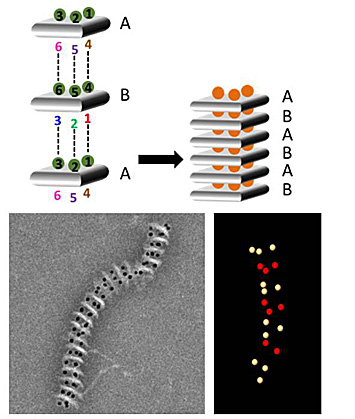Self-stacking DNA Tablets Construct Towers of Nanoparticles
August 21, 2017
What is the scientific achievement?
The mesoscale components of living cells are formed from small biomolecules, yet exhibit well-defined shapes. Inspired by Nature’s approach, CFN staff and users developed a similar assembly strategy for constructing inorganic nanomaterials. Using tablet-shaped DNA to hold nanoparticles at specified locations, the team programmed tablets to self-stack in a prescribed order — forming mesoscale pillars with precisely positioned nanoparticles.
Why does this achievement matter?
This research shows a new strategy for building nanomaterials, using programmable DNA to mediate the assembly and design material plasmonic properties.
What are the details?
(Top) Schematic of the DNA self-stacking process, used to assemble nanoparticles into pillars. (Bottom) Assembled pillars of DNA-nanoparticles imaged by (left) transmission electron microscopy, and (right) cryo-electron microscope tomography. enlarge
enlarge
CFN Capabilities:
CFN Materials Synthesis and Electron Microscopy Facilities were used to develop the assembly method and perform structural characterization.
Publication Reference
C. Tian, M. A. L. Cordeiro, J. Lhermitte, H. L. Xin, L. Shani, M. Liu, C. Ma, Y. Yeshurun, D. DiMarzio, O. Gang, ACS Nano 11, 7036 (2017).
DOI: 10.1021/acsnano.7b02671
Acknowledgement of Support
U.S. DOE Office of Science Facilities operated at Brookhaven National Laboratory under contract no. DE-SC0012704
BNL Laboratory Directed Research and Development program
NG Next, Northrop Grumman Corporation
Israel Science Foundation (ISF-164/12) and the German-Israeli Foundation for Scientific Research and Development (GIF) (I-1234-303.10/2014)
2017-12447 | INT/EXT | Newsroom









